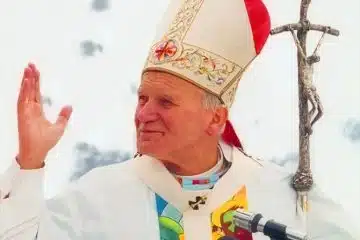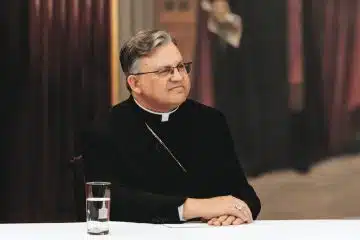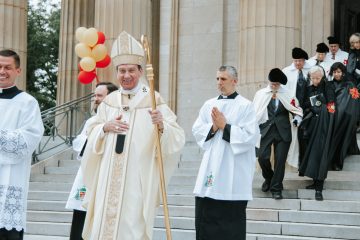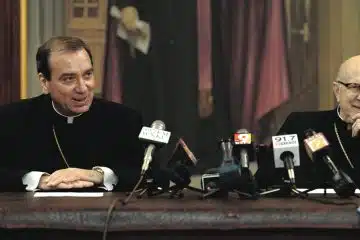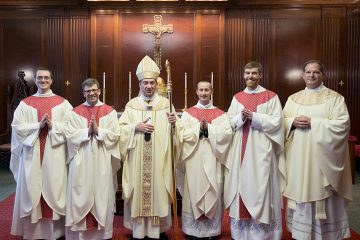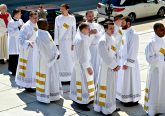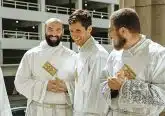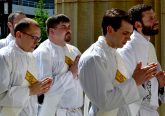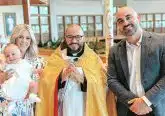Married former Episcopal priest a candidate for ordination

By John Stegeman
The Catholic Telegraph
In 2015, a married man is slated to be ordained as a Catholic priest for the Archdiocese of Cincinnati.
J. Thomas Wray, a married father of two, is now a Catholic but he is also a former Episcopal priest. Under a special Pastoral Provision issued by Pope St. John Paul II in 1980, former Episcopal clergy who convert to Catholicism can be ordained on a case-by-case basis, after approval by the Holy Father.
How does the Pastoral Provision work? Click here to learn more
Pope Francis granted the provision for Wray in March, and on June 15 he was admitted as a candidate for ordination in a ceremony during Mass celebrated by Auxiliary Bishop Joseph R. Binzer at St. Margaret of York in Loveland (SMOY). He was also installed as a lector and acolyte, both steps in the process toward ordination that all candidates for priesthood go through. Wray is not the first former Episcopal priest to become a Catholic priest for the Archdiocese of Cincinnati. The last priest to do so was Father David DeVore III, ordained in 1988. Father DeVore died in 2007.
“Today, appropriately on Father’s Day, Tom takes public steps toward his ordination as a priest,” Bishop Binzer said in his June 15 homily. “The steps Tom takes today are some of the same steps (SMOY Pastor) Father Jan (Schmidt), Father James (Brooks) and I took before we were ordained priests. Father Jan, Father James and I later promised that we would live a celibate life. Tom, since he is married, will not be asked to make that promise. This is not an ordination ceremony today. It is a ceremony where Tom is inscribed as a candidate for ordination, and receives the ministries of lector and acolyte. ”
Wray would also become the second married priest to serve in the archdiocese after Father Greg Lockwood. Father Lockwood was a former Lutheran ordained by the Archdiocese of St. Louis. He served in several capacities in this archdiocese, including assisting at St. Vincent de Paul Parish in Cincinnati. He has since returned to the St. Louis archdiocese.
Presently employed at a pastoral associate at SMOY, Wray and his wife Janet have two children. Katie is 20, and is a student at the University of South Carolina and James, 17, will be a senior at St. Xavier High School. The family was received together into the Catholic church in 2011.
Wray was ordained in the Episcopal church in 1990, the same year he married Janet. He has worked in four Anglo-Catholic or “high church” Episcopal parishes, two in Chicago and two in the Cincinnati area. He left his position in the Episcopal church in 2008 and worked secular jobs to support his family.
“I had to discern whether to stay comfortable in the Episcopal church, or did I want to tend to this voice that had been calling me for many years to come home to the Catholic church,” Wray said. “I thank God for the elements of truth and beauty in the Episcopal Church. However, over the course of many years the Holy Spirit helped me see that the source and summit of these gifts—the Eucharist, liturgy, Scripture — was in reality the Catholic Church. Ultimately, God helped me see that logically, there couldn’t be two holy, Catholic and apostolic Churches.”
Wray said the visible, doctrinal fragmentation within Anglican Communion, of which the Episcopal Church is a part, became for him the handwriting on the wall of a much larger problem, that of authority. Reading the church fathers also helped lead to his conversion.
“There really was no single issue that made me leave,” Wray said. “It really manifested as an inability for me to preach and teach pastorally about faith itself. For Janet, it was much more, I think, the almost-yearly splintering of our denomination into smaller and smaller, competing parties. She saw more clearly than I did the consequences of a church that chose to leave full communion with the Successor of Peter. It was increasingly more difficult for us intellectually to think of ourselves as Catholics when we saw the sad realities of deep divisions compromising our witness to the world. She so graciously agreed to follow me in and the kids did as well. All four of us came in together.”
Coming to believe in the truth of the Catholic faith was only part of Wray’s journey. After converting, he still hoped to serve in ordained ministry. Just because an Episcopal or Anglican priest converts to Catholicism, it does not mean they will be accepted as a candidate for ordination. To leave the Episcopal church meant Wray had to face the possibility of life as a layman.
“If the Holy Spirit saw fit, I was of course willing to continue (ordained ministry),” Wray said. “I saw this as an opportunity to act on Jesus’ passionate desire that his disciples would live in full, visible unity (John 17.21). At the same time, I was being asked to offer this up. You have to be. In the Catholic church there’s no sense of personal or guaranteed ordination, it is a grace. It took a lot of letting go of what I thought was mine and entrusting that to the Holy Spirit saying, ‘Alright Lord, if I’m meant to be a layperson for the rest of my life, I’m ready to do that in the Catholic church.’ I was just so relieved and happy to come home.”
Now accepted as a candidate, Wray said he is scheduled to be ordained a deacon on Sept. 13. If all goes as planned, he’ll be ordained a priest sometime in 2015. The process for those former Episcopal and Anglican priests coming into the Catholic fold requires several years of prayer and study. There are also certifications one must obtain and written and oral exams. Wray has completed those processes.
Dan Andriacco, director of communications for the Archdiocese of Cincinnati, noted that Wray’s acceptance as a candidate and pending ordination do not represent any changes in church teaching.
“Celibate clergy remain the norm for Catholic priests of the Roman rite, but this is a matter of discipline, not dogma,” Andriacco said. “Married men can be ordained priests in the Eastern rites of the Catholic Church (outside the United States), as they always have been. In the West, however, allowing married former clergy of other faiths to be ordained as Catholic priests after appropriate preparation and study is a pastoral concession — a kind of favor to make their transition to the Catholic church easier. If their wives die, they’re not to remarry; the same is true of married permanent deacons.”
Married priests entering the church through the Pastoral Provision serve in roles other than that of pastor.
Despite possible misconceptions, at the Father’s Day ceremony at SMOY, Wray said he felt nothing but love and acceptance.
“It was literally being embraced by the community and being blessed by them,” Wray said. “Bishop Binzer was so gracious in being here and teaching the parish what the Provision is, and how it works and introducing my family.”
Wray stressed that though he is a married priest, he is not an advocate for a married priesthood. In fact, he opposes that change in church discipline. He said others who have come in through the Pastoral Provision feel the same way.
“We’re not advocates for the end of celibacy,” he said. “We’re very strong supporters of the celibacy laws and we see ourselves as exceptions to that. The exception proves the rule. We can see why… In Anglicanism, we joked that parish ministry at times was like a “jealous mistress.” You knew there was never enough of you to go around.”
Another method by which former Anglicans and Episcopalians join the church is the Personal Ordinariate of the Chair of St. Peter. Wray said the pastoral provision is for individuals like him, while the Ordinariate is a route to communion for a situation wherein a pastor and congregation desire to come into union with the Catholic church together.
Wray said his formation isn’t complete and he knows he still has much to learn before ordination. Still, he’s grateful to be home in the Catholic church.
“Thank you, and please be patient with me and my family,” Wray said. “We’re not here to change anything, but to continue. There will be a steep learning curve for me and my family and I wonder if there might not be a learning curve for the archdiocese as well.”
This article originally appeared in the July 2014 print edition of The Catholic Telegraph.




